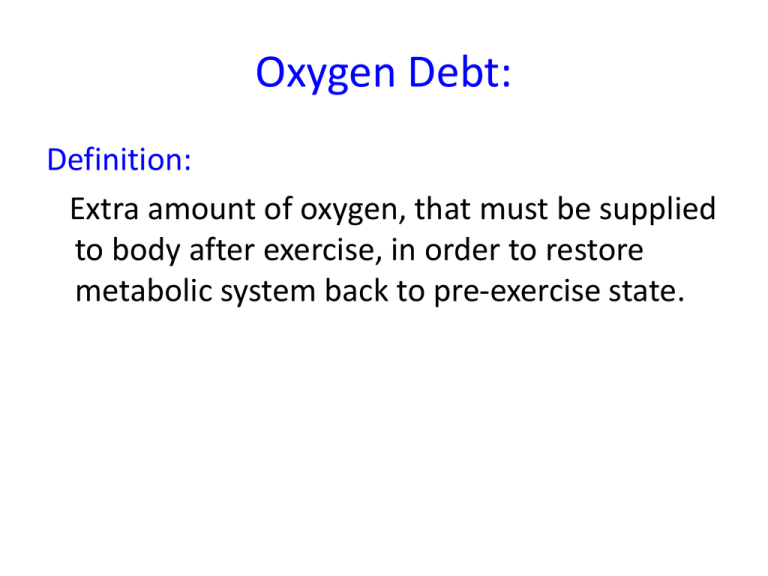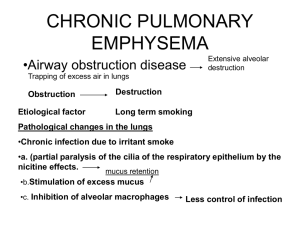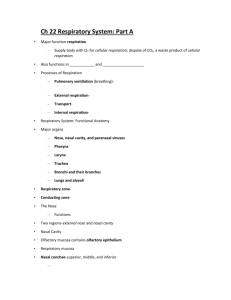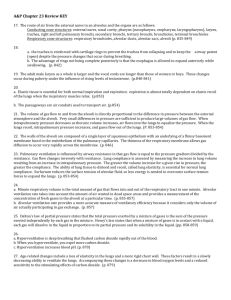chap 42, my lecture 1
advertisement

Oxygen Debt: Definition: Extra amount of oxygen, that must be supplied to body after exercise, in order to restore metabolic system back to pre-exercise state. • During exercise oxygen consumption is increased by skeletal muscle. Oxygen is present: • In combination with Hb • In myoglobin & • In dissolved form Oxygen used in severe exercise: 0.3 L O2 combined with Myoglobin 1L O2 combined with Hemoglobin 0.5 L O2 in alveolar air 0.25 L O2 in dissolved form TOTAL OXYGEN = 2 L (approx.) This much oxygen must be repaid. Debts: • To restore phosphagen & glycogen system: 2 L is required. • To restore Aerobic system: 8 L is required. • So, a total of 10-12 L oxygen is used in exercise & is paid in 90 min after exercise respiratory rate remain increased for 90 min after exercise to repay oxygen debt = 10-12 L. Chronic Obstructive Pulmonary Disease (COPD) • Chronic pulmonary emphysema – It is one of the obstructive respiratory diseases in which lung tissue is extensively damaged. – This literally means that air is trapped in the lungs. • Chronic bronchitis – excessive mucus production • Asthma – bronchiole constriction CHRONIC PULMONARY EMPHYSEMA •Airway obstruction disease Etiological factor : Long term smoking Extensive alveolar destruction Pathological changes in the lungs: •Chronic infection due to irritant smoke •Stimulation of excess mucus • Inhibition of alveolar macrophages Less control of infection •(partial paralysis of the cilia of the respiratory epithelium by the nicotine mucus retention effects • Infection+ Inflammation Of bronchioles •Obstruction of airways Chronic obstruction of airways Difficult expiration Entrapment of air in alveoli and overstretching Lung infection 50-80 % of alveolar wall destruction Physiological abnormalities of emphysema 1. Increased air way resistance leads to increased work of breathing 2. Loss of alveolar walls leads to decreased diffusing capacity 3. Hypoxia, hypercapnia death 4. Right heart failure. 5. Abnormal ventilation perfusion ratio in same lung Physiological dead space( Va/Q) • Loss of alveolar wall No. of pulm. capill Pulm. Vasular resistance Pulmonary hypertension Right heart failure ASTHMA • Severe airway obstruction due to spastic contraction of the smooth muscle in the bronchioles which leads to the difficulty in breathing. • Etiology • hypersensitivity of the bronchioles in response to the foreign substances in air. • Allergic hypersensitivity (plant pollens)- YOUNG • Non –allergic irritants -OLD • Specific Ag + IgE On mast cells (Pollen ,he is sensitive which is inhaled.) Increased airway resistance In expiration due to external pressure Allergic reactions Histamine Edema+ mucus Smooth muscle spasm Bradykinin Eosinophilic Chemotactic factor Slow reacting substanc e of Anaphyl axis(mixt ure of leucotrie nes) • Clinical results Maximum expiration rate Dyspnea/air hunger Expiration volume Acute asthmatic attack Functional residual capacity Difficulty in expiring Residual volume Barrel chest Permanent enlargement of chest over years Atelectasis Causes: 1) airway obstruction with mucus and solid object 2) Lack of surfactant in fluids lining the alveoli Effects: 1) Lung collapse lead to compression of veins 2) increase blood flow resistance 3) Additional vasoconstriction due to hypoxia in collapsed alveoli Atelectasis • Vasoconstriction lead to decrease blood flow through Atelectasis lung: – 1)blood5/6 passes to aerated lung – 2)Blood 1/6 passes to unaerated lung – V/Q ratio is moderately compromised – only mild oxygen desaturation in aortic blood despite total loss of ventilation in an entire lung Lack of surfactant as a cause of lung collapse • Special alveolar epithelial cells secrete surfactant leads to fluid that coat inside surface of alveoli lead to 2-10 times decrease surface tension in alveoli which prevents alveolar collapse • In case of RDS in newborn premature babies, alveoli lead to decrease surfactant result in increase surface tension lead to lung collapse patient may die due to suffocation with Atelectasis. Tuberclosis • A constrictive lung disease Etiology: tubercle bacilli lead to tissue reaction in lungs lead to Pathology: 1) Macrophage invasion 2) Walling off of lesion by fibrous tissue leading to tubercle formation 3) If untreated in 3% walling off fails 4) Massive destruction of lung tissue 5) Large abcess cavities 6) Late stages= increase fibrous tissue and decrease function of lung tissue. Physiologic abnormalities of tuberculosis: 1. Increase work of breathing by respiratory membrane 2. Decrease respiratory membrane surface area 3. Increase thickness of respiratory membrane 4. Decrease vital capacity 5. Decrease breathing capacity 6. Decrease pulmonary diffusion capacity 7. Abnormal ventilation perfusion ratio pneumonia • It is an infection of pulmonary parenchyma. • It may involve primarily the interstium or alveoli • Caused by viruses,fungi,and parasites. Pneumonia • Involvement of entire lobe is called LOBAR PNEUMONIA • Involvement of alveoli contiguous to bronchi is called BRONCHOPNEUMONIA pneumonia • Abnormalities of function (Pathology): – Consolidation of lung occurs i.e, alveoli are filled with blood cells and fluids – Pulmonary membrane becomes inflamed and porous so leaking occurs. – Decrease total surface area of respiratory membrane – Decrease V/Q ratio which results in hypoxemia and hypercapnia










